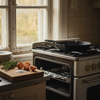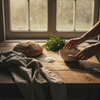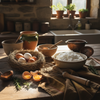Baking Essentials Guide: Proven Tools & Techniques
Key Takeaways
- Quality baking tools are essential for achieving consistent and professional results.
- Using fresh ingredients stored properly ensures the best flavor and texture in your baked goods.
- Accurate measuring is crucial to avoid common baking mishaps like sunken cakes.
- Mastering the right techniques, such as knowing when to fold or whisk, elevates your baking skills.
- Combining the right tools, ingredients, and techniques transforms baking from a guesswork into a reliable process.
Table of Contents
- What Are Baking Essentials?
- Stocking the Ultimate Baking Pantry: Must-Have Ingredients & How They Work
- Precision in Practice: Measuring Tools Every Baker Needs
- Mixing Methods Decoded: Tools & Tips for Every Batter and Dough
- Choosing the Right Bakeware: A Material, Shape, and Size Showdown
- The Spatula Matters: Why Smart Bakers Invest in Quality Tools
- Organizing Your Workspace: Setup, Storage, and Maintenance
Baking Essentials Guide: Proven Tools & Techniques for Home Baking Success
Transform your kitchen into a confident baker's domain with the right baking essentials guide. Whether you're tackling your first sourdough or perfecting holiday cookies, success hinges on three pillars: quality tools that perform under pressure, fresh ingredients stored properly, and techniques that turn "what if" into "what's next." The difference between a sunken cake and Instagram-worthy layers often comes down to having the right spatula, measuring accurately, and knowing when to fold versus when to whisk.
This comprehensive baking essentials guide cuts through the kitchen gadget noise to focus on what actually matters, tools that won't melt, bend, or expose your family to forever chemicals, ingredients that deliver consistent results, and proven methods that work every time. From DI ORO's award-winning spatulas (recognized by America's Test Kitchen and Food Network) to the science behind perfect measurements, we're covering everything you need to bake boldly and serve with confidence. For more on choosing the right utensils, see this guide to top rated seamless spatulas for baking.
What Are Baking Essentials?
Baking essentials encompass the foundational tools, premium ingredients, and proven techniques that separate successful home bakers from those still scraping burnt cookies off pans. Unlike cooking, where you can improvise and taste-test along the way, baking demands precision, the right measuring tools, heat-resistant spatulas that won't contaminate your batter, and fresh leavening agents that actually work when you need them.
The magic happens when these three elements align: professional-grade tools that perform consistently (like DI ORO's seamless silicone spatulas, tested to 600°F and free of forever chemicals), pantry staples stored for maximum potency, and techniques that ensure even mixing without overworking your dough. Master bakers know that essentials aren't about having the most equipment, they're about having the right equipment that delivers results every single time.
Minimum Kit vs. Aspirational Setup
Starter Essentials: Digital scale, mixing bowls, one versatile spatula, basic measuring tools, two sheet pans
Ambitious Baker's Arsenal: Stand mixer, multiple spatula sizes, specialty pans, ingredient upgrades, precision thermometers
The beauty of a well-planned baking essentials guide lies in building confidence through consistency. When your tools perform reliably and your ingredients are fresh, you're free to focus on creativity and technique rather than wondering why your batter looks wrong or your spatula just melted into your brownies.
Stocking the Ultimate Baking Pantry: Must-Have Ingredients & How They Work

Your baking pantry forms the foundation of every successful recipe, and freshness directly impacts your results. All-purpose flour maintains peak performance for 6-8 months in airtight containers, while baking powder loses potency after 18 months, test it by dropping a teaspoon into hot water; it should bubble vigorously. Stock these core categories: unbleached all-purpose flour, granulated and brown sugars, baking powder and soda, unsalted butter, eggs, pure vanilla extract, and fine sea salt.
Understanding ingredient function transforms your baking from guesswork to science. Baking powder provides lift through double-acting bubbles, while baking soda requires acid to activate, swap them incorrectly and your muffins turn into hockey pucks. Brown sugar adds moisture and molasses flavor; granulated sugar creates structure and browning. Store opened yeast in the refrigerator for up to 4 months, and keep vanilla extract in a cool, dark place where it actually improves with age.
Smart substitutions save recipes when you're missing ingredients: create cake flour by removing 2 tablespoons from 1 cup all-purpose flour and adding 2 tablespoons cornstarch. Replace buttermilk with 1 cup milk plus 1 tablespoon lemon juice, let stand 5 minutes. However, never substitute baking powder for baking soda without adjusting acid levels, chemistry matters in baking.
Temperature control extends ingredient life and maintains quality. Butter should be stored at 65-67°F for optimal creaming, too cold won't incorporate air, too warm creates greasy batter. Eggs perform best at room temperature for volume, but store them refrigerated and bring to room temperature in warm water for 10 minutes before use.
Precision in Practice: Measuring Tools Every Baker Needs
Accuracy separates successful baking from kitchen disasters, a difference of 30 grams of flour can turn tender cake into dense brick. Digital scales provide precision to the gram, while volume measurements vary based on how you scoop, settle, or pack ingredients. Professional bakers measure by weight because 1 cup of flour can weigh anywhere from 120-150 grams depending on technique.
Master the spoon-and-level method for flour when using cups: spoon flour into the measuring cup without packing, then level with a knife. Never scoop directly from the bag, this compacts flour and adds 30% more than recipes intend. For liquids, use clear measuring cups with spouts, checking at eye level on a flat surface for accuracy. For more tips on choosing the right vessel, see this article on the liquid measuring cup.
Your minimum precision kit needs just four items: one digital scale accurate to 1 gram, one set of dry measuring cups, one 2-cup liquid measuring pitcher, and measuring spoons including 1/8 teaspoon for precise spice work. This combination handles 95% of home baking scenarios while maintaining the accuracy that separates amateur results from bakery-quality treats.
Professional tip: Download a conversion app or print a chart for instant gram-to-cup conversions. When recipes list ingredients by weight, your digital scale becomes your most valuable tool, no sifting, no guessing, just consistent results every time you bake.
Mixing Methods Decoded: Tools & Tips for Every Batter and Dough
Mixing technique controls gluten development, air incorporation, and ingredient distribution, the holy trinity of texture in baking. Overmix muffin batter and tough, tunneled results follow; undermix cake batter and you'll find flour pockets in your finished product. The science lies in understanding when to build structure (bread dough) versus when to preserve tenderness (quick breads).
Stand mixers excel at heavy doughs and lengthy creaming, while hand mixers offer control for delicate batters. However, the unsung hero remains the spatula, DI ORO's award-winning silicone spatulas, recognized by America's Test Kitchen as the most versatile on the market, handle folding without deflating air bubbles. Their seamless design prevents bacteria buildup, while pro-grade silicone withstands 600°F without leaching forever chemicals into your batter. For a deeper dive into the benefits of these utensils, check out this post on spatulas.
Perfect creaming technique requires room-temperature butter (65-67°F) beaten with sugar for 3-5 minutes until pale and fluffy, this creates tiny air pockets that leaven your cake. For folding delicate ingredients like whipped cream or beaten egg whites, use a flexible spatula in a cutting motion: slice down through the center, sweep across the bottom, and lift up the sides. Count your folds, muffins need just 25-30 gentle turns until ingredients barely combine.
Hand mixing cookie dough prevents overworking gluten that makes cookies tough, while stand mixers save time for bread dough that requires 8-10 minutes of kneading. The key is matching tool intensity to desired outcome: gentle incorporation for tender results, vigorous mixing for structure and strength.
Choosing the Right Bakeware: A Material, Shape, and Size Showdown

Bakeware material directly affects heat conduction, browning, and release, choose wrong and even perfect batter fails. Metal pans conduct heat efficiently for crispy edges and golden bottoms, glass bakeware heats slowly but retains heat longer, while silicone offers easy release but minimal browning. Your core collection needs just six pieces: two sheet pans, one 9-inch round cake pan, one 9x13 rectangular pan, one loaf pan, and one 12-cup muffin tin. For more on selecting the best pans, see this helpful baking pan guide.
| Material | Heat Conduction | Browning Ability | Release Quality | Cleaning Ease | Best Applications |
|---|---|---|---|---|---|
| Aluminum | Excellent | Even golden browning | Requires prep | Hand wash recommended | Cookies, sheet cakes, roasting |
| Stainless Steel | Moderate | Good browning | Needs greasing | Dishwasher safe | Bread, sturdy cakes |
| Glass | Slow, even | Deep browning | Good with prep | Easy cleaning | Casseroles, fruit crisps |
The Spatula Matters: Why Smart Bakers Invest in Quality Tools
Seamless construction eliminates bacteria-harboring crevices that plague traditional spatulas with separate heads and handles. DI ORO's award-winning spatulas, recognized by America's Test Kitchen as the Best Silicone Spatula and Food Network's Best Spoonula, feature pro-grade silicone molded around stainless steel cores that won't bend under pressure or melt at high temperatures.
Forever chemical safety matters when tools touch your food. DI ORO spatulas contain zero PFAS, PFOA, or other persistent chemicals that traditional non-stick coatings release. Heat resistance to 600°F means no melting, warping, or chemical breakdown during stovetop cooking, wooden spatulas char and crack, while cheap silicone degrades at high heat.
The 30-Second Spatula Test: After mixing thick brownie batter, a quality flexible spatula should scrape the bowl completely clean in one smooth motion. Rigid spatulas leave behind 2-3 tablespoons of batter, enough to affect texture and waste expensive ingredients like chocolate and vanilla.
Technique precision improves with proper tools: flexible edges conform to bowl curves for complete scraping, while firm cores provide control for folding delicate meringues without deflating. The spoon-shaped head design excels at both stirring and serving, eliminating tool switches mid-recipe.
Nonstick pan safety requires silicone over metal, even gentle metal spatulas create microscopic scratches that compromise coating integrity. DI ORO's smooth silicone edges preserve pan surfaces while their seamless design cleans effortlessly in dishwashers without trapping food particles. For more on choosing the best spatula for your needs, see this article on the baking spatula.
Organizing Your Workspace: Setup, Storage, and Maintenance
The baker's triangle optimizes workflow: position your mixing station, ingredient storage, and oven within three steps of each other. Place measuring tools in the zone between ingredients and mixing bowls, keeping frequently used items like vanilla and salt at arm's reach. This setup reduces cross-contamination and prevents ingredient omissions during complex recipes.
Vertical storage maximizes limited space: nest mixing bowls, stack same-size pans with parchment between them, and use adjustable dividers for sheet pans. Store measuring cups on hooks inside cabinet doors, keeping counters clear for actual work. Designate one drawer exclusively for essential tools, spatulas, whisks, measuring spoons, so you never hunt mid-recipe.
Silicone tool maintenance requires specific care: hand wash immediately after use with dish soap and hot water, or run through dishwasher cycles. For stubborn odors, create a paste with baking soda and water, scrub gently, then rinse. Unlike wooden tools that absorb flavors and harbor bacteria, properly maintained silicone spatulas remain odor-free and stain-resistant for years.
Multi-recipe preparation demands systematic organization: set out all ingredients before starting, pre-measure everything into small bowls, and clean tools between recipes to prevent flavor transfer. This mise en place approach, borrowed from professional kitchens, eliminates scrambling and reduces errors during busy baking sessions. For a comprehensive overview of baking techniques and best practices, consult this external resource on baking techniques.
If you're interested in furthering your baking knowledge, you may also find this comprehensive baking and pastry arts guide helpful.
Frequently Asked Questions
What are the most important baking tools every home baker should have?
Every home baker should have quality measuring tools like digital scales and measuring cups, heat-resistant silicone spatulas for mixing and scraping, and reliable bakeware suited to their recipes. These essentials ensure precision, durability, and ease, helping you bake with confidence and consistency.
How does proper ingredient storage impact the flavor and texture of baked goods?
Proper ingredient storage preserves freshness, which directly affects the flavor and texture of your baked goods. Keeping ingredients like flour, baking powder, and nuts in airtight containers away from heat and moisture ensures they perform optimally, resulting in better rise, taste, and crumb.
Why is accurate measuring crucial in baking, and what tools can help achieve it?
Accurate measuring is vital because baking is a science where even small deviations can cause issues like sunken cakes or dense bread. Tools like digital kitchen scales and standardized measuring spoons help you achieve precise measurements, turning guesswork into reliable results every time.
What are the key techniques that can improve baking results, such as folding versus whisking?
Mastering techniques like folding and whisking can elevate your baking by controlling texture and structure. Folding gently incorporates air without deflating batter, perfect for delicate cakes, while whisking vigorously aerates mixtures for lightness. Using the right tools, like DI ORO’s award-winning spatulas, makes these techniques easier and more effective.




